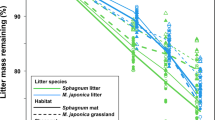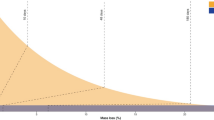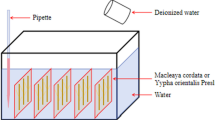Abstract
As part of a tier 3 risk assessment performed for a uranium mining area, the ability of soils with different degrees of metal contamination to degrade organic matter was assessed using litter bags filled with leaves of Quercus robur, Pinus pinaster, Salix atrocinerea, or a mixture of the three species. Litter bags were exposed at different sites within the mine area and at a reference area for 3, 6, 9, and 12 months. Biomass loss, nitrogen (N), phosphorus (P), carbon (C) and total fatty acid, total phenolic, and ergosterol contents were assessed for each litter bag retrieved from the field. The decomposition of litter at each site seemed to be governed by a complex interaction of many different factors. After 12 months of exposure, leaves from the most contaminated sites were distinguishable from those from the reference site. In the reference site, the greatest percentages of biomass loss were attained by Q. robur and P. pinaster leaves. These species displayed the second highest and the lowest C-to-N ratios, respectively. In addition, the high P content of the litter from these two species may have favored microbial colonization. The results suggest that the decomposition of P. pinaster and Q. robur leaves may have been favored at the reference site by the high abundance of both species at this site and the subsequent adaptation of the microbial community to their litter. Our study shows that different species of leaf litter should be used to discriminate between contaminated sites with different levels of contamination.





Similar content being viewed by others
References
Aerts R (1997) Climate, leaf litter chemistry and leaf litter decomposition in terrestrial ecosystem: a triangle relationship. Oikos 79:439–449
André A, Antunes SC, Gonçalves F, Pereira R (2009) Bait-lamina assay as a tool to assess the effects of metal contamination in the feeding activity of soil invertebrates within a uranium mine area. Environ Pollut 157:2368–2377
Antunes SC, Castro BB, Pereira R, Gonçalves F (2008) Contribution for Tier 1 of the Ecological Risk Assessment of Cunha Baixa Uranium Mine (Central Portugal): II. Soil ecotoxicological screening. Sci Total Environ 390:387–395
Antunes SC, Pereira R, Marques SM, Castro BB, Gonçalves F (2011) Impaired microbial activity caused by metal pollution: a field study on a deactivated uranium mining area. Sci Total Environ 410–411:87–95
Antunes SC, Castro BB, Moreira C, Gonçalves F, Pereira R (2013) Community-level effects in edaphic fauna from an abandoned mining area: integration with chemical and toxicological lines of evidence. Ecotoxicol Environ Saf 88:65–71
Asplund J, Bokhorst S, Wardle DA (2013) Secondary compounds can reduce the soil micro-arthropod effect on lichen decomposition. Soil Biol Biochem 66:10–16
Barajas-Aceves M, Hassan M, Tinoco R, Vazquez-Duhalt R (2002) Effect of pollutants on the ergosterol content as indicator of fungal biomass. J Microbiol Methods 50:227–236
Barrios E (2007) Soil biota, ecosystem services and land productivity. Ecol Econ 64:269–285
Bárta J, Applová M, Vanĕk D, Krištůfková M, Šantrůčkova H (2010) Effect of available P and phenolics on mineral N release in acidified spruce forest: connection with lignin-degrading enzymes and bacterial and fungal communities. Biogeochemistry 97:71–87
Beare MH, Parmelee RW, Hendrix PF, Cheng W, Coleman DC, Crossley DA (1992) Microbial and faunal interactions and effects on litter nitrogen and on decomposition in agro ecosystem. Ecol Monogr 62:569–591
Boeriu CG, Bravo D, Gosselink RJA, van Dam JEG (2004) Characterisation of structure dependent functional properties of lignin with infrared spectroscopy. Ind Crops Prod 20:205–218
Bonanomi G, Incerti G, Giannino F, Mingo A, Lanzotti V, Mazzoleni S (2013) Litter quality assessed by solid state 13C NMR spectroscopy predicts decay rate better than C/N and lignin/N ratios. Soil Biol Biochem 56:40–48
Conn C, Dighton J (2000) Litter quality influences on decomposition, ectomycorrhizal community structure and mycorrhizal root surface acid phosphatase activity. Soil Biol Biochem 32:489–496
Cotrufo MF, De Santo AV, Alfani A, Bartoli G, De Cristofano A (1995) Effects of urban heavy metal pollution on organic matter decomposition in Quercus ilex L. woods. Environ Pollut 89:81–88
Coûteaux M-M, Bottner P, Berg B (1995) Litter decomposition, climate and litter quality. Tree 10:63–66
Davidson DA, Grieve IC (2006) Relationships between biodiversity and soil structure and function: evidence from laboratory and field experiments. Appl Soil Ecol 33:176–178
De Silva PMCS, Pathirane A, van Straalen NM, van Gestel CAM (2010) Chlorpyrifos causes decreased organic matter decomposition by suppressing earthworms and termite communities in tropical soil. Environ Pollut 158:3041–3047
Dighton J, Mascarenhas M, Arbuckle-Keil GA (2001) Changing resources: assessment of leaf litter carbohydrate resource changes at a microbial scale of resolution. Soil Biol Biochem 33:1429–1432
Drzewiecka K, Mleczek M, Gąsecka M, Magdziak Z, Goliński P (2012) Changes in Salix viminalis L. cv. ‘Cannabina’ morphology and physiology in response to nickel ions—hydroponic investigations. J Hazard Mater 217–218:429–438
Dumat C, Quenea K, Bermond A, Toinen S, Benedetti MF (2006) Study of the trace metal ion influence on the turnover of soil organic matter in cultivated contaminated soils. Environ Pollut 142:521–529
Faber JH, van Vensen J (2012) Elaborations on the use of the ecosystems services concepts for application in ecological risk assessment for soils. Sci Total Environ 415:3–8
Gartner TB, Cardon ZG (2006) Site of leaf origin affects how mixed litter decomposes. Soil Biol Biochem 38:2307–2317
Gąsecka M, Mleczek M, Drzewiceka K, Magdziak Z, Rissmann I, Chadzinikolau T et al (2012) Physiological and morphological changes in Salix viminalis L. as a result of plant exposure to copper. J Environ Sci Health A 47:548–557
Gholz HI, Wedin DA, Smitherman SM, Harmon ME, Parton WJ (2000) Long-term dynamics of pine and hardwood litter in contrasting environments: toward a global model of decomposition. Glob Change Biol 6:751–765
Guedes MJ, Pereira R, Duarte K, Rocha-Santos TAP, Antunes SC, Gonçalves F et al (2011) Sterols and fatty acid biomarkers as indicators of changes in soil microbial communities in a uranium mine area. J Environ Health A 46:1–10
Harrison AF (1971) The inhibitory effect of oak leaf litter tannins on the growth of fungi, in relation to litter decomposition. Soil Biol Biochem 3:167–172
Incerti G, Bonanomi G, Giannino F, Rutigliano FA, Piermatteo D, Castaldi S et al (2011) Litter decomposition in Mediterranean ecosystems: modelling the controlling role of climatic conditions and litter quality. Appl Soil Ecol 49:148–157
Irmler U (2000) Changes in the fauna and its contribution to mass loss and N release during leaf litter decomposition in two deciduous forests. Pedobiologia 44:105–118
Joergensen RG, Wichern F (2008) Quantitative assessment of the fungal contribution to microbial tissue in soil. Soil Biol Biochem 40:2977–2991
Kantouch A, El-Sayed AA, Salama M, El-Kheir AA, Mowafi S (2013) Salicylic acid and some of its derivatives as antibacterial agents for viscose fabric. Int J Biol Macromol 62:603–607
Kemp PR, Reynolds JF, Virginia RA, Whitford WJ (2003) Decomposition of leaf and root litter of Chihuahuan desert shrubs: effect of three years of summer drought. J Arid Environ 53:21–39
Lavelle P, Blanchart E, Martin A, Spain A, Toutain F, Barois I et al (1993) A hierarchical model for decomposition in terrestrial ecosystems: application to soil of the humid tropics. Biotropica 25:130–150
Li Q, Moorhead DL, De Forest J, Henderson R, Chen J, Jensen R (2009) Mixed litter decomposition in a managed Missouri Ozark forest ecosystem. For Ecol Manag 257:688–694
Liao M, Xie XM (2007) Effect of heavy metals on substrate utilization pattern, biomass, and activity of microbial communities in a reclaimed mining wasteland of red soil area. Ecotoxicol Environ Saf 66:217–223
Llugany M, Martin SR, Barceló J, Poschenrieder C (2013) Endogenous jasmonic and salicylic acids levels in the Cd-hyperaccumulator Noccaea (Thlaspi) praecox exposed to fungal infection and/or mechanical stress. Plant Cell Rep 32:1243–1249
Lorenz K, Preston CM, Krumrei S, Feger K (2004) Decomposition of needle/leaf litter from Scots pine, black cherry, common oak and European beech at conurbation forest site. Eur J For Res 123:177–188
Lourenço J, Pereira R, Silva A, Morgado J, Carvalho F, Oliveira J et al (2011a) Genotoxic endpoints in the earthworms sub-lethal assay to evaluate natural soils contaminated by metals and radionuclides. J Hazard Mater 186:788–795
Lourenço J, Silva A, Carvalho F, Oliveira J, Malta M, Mendo S et al (2011b) Histopathological changes in the earthworm Eisenia andrei associated with the exposure to metals and radionuclides. Chemosphere 85:1630–1634
Lourenço J, Pereira R, Silva A, Carvalho F, Oliveira J, Malta M et al (2012) Evaluation of the sensitivity of genotoxicity and cytotoxicity endpoints in earthworms exposed in situ to uranium mining wastes. Ecotoxicol Environ Saf 75:46–54
Madritch MD, Hunter MD (2004) Phenotypic diversity and litter chemistry affect nutrient dynamics during litter decomposition in a two species mix. Oikos 105:125–131
Merckx R, Brans K, Smolders E (2001) Decomposition of dissolved organic carbon after soil drying and rewetting as an indicator of metal toxicity in soils. Soil Biol Biochem 33:235–240
Mesman M, Jensen J, Rutgers M, Bierkens J (2006a) Decision support system for ecological risk assessment. In: Jensen J, Mesman M (eds) Ecological risk assessment of contaminated land. Decision support for site specific. Report number 711701047. RIVM. http://www.rivm.nl/bibliotheek/rapporten/711701047.pdf. Accessed Dec 2012
Mesman M, Rutgers M, Jensen J (2006b) Using the Triad in site specific assessment of contaminated soil. In: Jensen J, Mesman M (ed) Ecological risk assessment of contaminated land. Decision support for site specific. Report number 711701047. RIVM. http://www.rivm.nl/bibliotheek/rapporten/711701047.pdf. Accessed Dec 2012
Mfilinge PF, Meziane T, Bachok Z, Tsuchiya M (2003) Fatty acids in decomposing mangrove leaves: microbial activity, decay and nutritional quality. Mar Ecol Prog Ser 265:97–105
Michell AJ (1990) Second-derivative FT-IR spectra of native celluloses. Carbohydr Res 197:53–60
Moretto JS, Distel RA, Didoné NG (2001) Decomposition and nutrient dynamic of leaf litter and roots from palatable and unpalatable grasses in a semi-arid grassland. Appl Soil Ecol 18:31–37
Mulinacci N, Romani A, Galardi C, Pinelli P, Giaccerini C, Vincieri F (2001) Polyphenolic content in olive oil waste waters and related olive samples. J Agric Food Chem 49:3509–3514
Mummey DL, Stahl PD, Buyer JS (2002) Soil microbiology properties 20 years after surface mine reclamation: spatial analysis of reclaimed and undisturbed sites. Soil Biol Biochem 34:1717–1725
Niemeyer JC, Nogueira MA, Carvalho GM, Cohin-De-Pinho SJ, Outeiro US, Rodrigues GG et al (2012) Functional and structural parameters to assess the ecological status of a metal contaminated area in the tropics. Ecotoxicol Environ Saf 86:188–197
Oades JM (1988) The retention of organic matter in soils. Biogeochemistry 5:35–70
Pereira R, Sousa JP, Ribeiro R, Gonçalves F (2006) Microbial indicators in mine soils (S. Domingos Mine, Portugal). Soil Sediment Contam 15:147–167
Pereira R, Antunes SC, Marques SM, Gonçalves F (2008) Contribution for Tier 1 of the Ecological Risk Assessment of Cunha Baixa Uranium Mine (Central Portugal): I. Soil chemical characterization. Sci Total Environ 390:377–386
Pereira R, Marques CR, Silva Ferreira MJ, Neves MFJV, Caetano AL, Antunes SC et al (2009) Phytotoxicity and genotoxicity of soils from an abandoned uranium mine area. Appl Soil Ecol 42:209–220
Pereira R, Barbosa S, Carvalho FP (2014) Uranium mining in Portugal: a review of the environmental legacies of the largest mines and environmental and human health impacts. Environ Geochem Health 36:285–301
Pérez HN, Díaz S, Vendramini F, Gurvich DE, Cingolani AM, Giorgis M et al (2007) Direct and indirect effects of climate on decomposition in native ecosystems from central Argentina. Austral Ecol 32:749–757
Pleguezuelo CRR, Zuazo VHD, Fernández LJM, Peinado FJM, Tarifa DF (2009) Litter decomposition and nitrogen release in a sloping Mediterranean subtropical agroecosystem on the coast of Granada (SE, Spain): effects of floristic and topographic alteration on the slope. Agric Ecosyst Environ 134:79–88
Pulford ID, Watson C (2003) Phytoremediation of heavy metal-contaminated land by trees—a review. Environ Int 29:529–540
Quinn GP, Keoug MJ (2002) Experimental design and data analysis for biologists. University Press, Cambridge, UK, Cambridge
Rahman MM, Tsukamoto J, Rahman M, Yoreyama A, Mostafa KM (2013) Lignin and its effects on litter decomposition in forest ecosystems. Chem Ecol 29:540–553
Römbke J, Heimbach F, Hoy S, Kula C, Scott-Fordsmand J, Sousa P et al (eds) (2003) Effects of plant protection products on functional endpoints in soil (EPFES, Lisbon 2002). SETAC, Pensacola
Ross DJ, Tate KR, Newton PCD, Clark H (2002) Decomposability of C3 and C4 grass litter sampled under different concentrations of atmospheric carbon dioxide at natural CO2 spring. Plant Soil 240:275–286
Scheid S, Günthard-Goerg MS, Schulin R, Nowack B (2009) Accumulation and solubility of metals during leaf litter decomposition in non-polluted and polluted soil. Eur J Soil Sci 60:613–621
Schneider T, Keiblinger KM, Schmid E, Sterflinger-Gleixner K, Ellersdorfer G, Roschitzki B et al (2012) Who is who in litter decomposition? Metaproteomics reveals major microbial players and their biogeochemical functions. ISME J 6(9):1749–1762
Seneviratne G (2000) Litter quality and nitrogen release in tropical agriculture: a synthesis. Biol Fertil Soil 31:60–64
Silva L, Cachada A, Freitas AC, Pereira R, Rocha-Santos TA, Duarte AC (2010) Assessment of fatty acid as differentiator of usages of urban soil. Chemosphere 81:968–975
Šnajdr J, Cajthaml T, Valáašková V, Merhautová V, Petránková M, Spetz P et al (2011) Transformation of Quercus petraea litter: successive changes in litter chemistry are reflected in differential enzyme activity and changes in the microbial community composition. FEMS Microbiol Ecol 75:291–303
Socrates G (1994) Infrared characteristic group frequencies, 2nd edn. Wiley, West Sussex
Stewart D (1995) Fourier-transform infrared microspectroscopy of plant tissues. Appl Spectrosc 50:357–365
Van Bergen PF, Nott CJ, Bull ID, Poulton PR, Evershed RP (1998) Organic geochemical studies of soils from Rothamsted Classical Experiments. IV. Preliminary results of a study of the effect of soil pH on organic matter decay. Org Geochem 29(5–7):1779–1795
Vanderbilt KL, White CS, Hopkins O, Craig JA (2008) Aboveground decomposition in arid environments: results of a long-term study in central New Mexico. J Arid Environ 72:696–709
Vivanco L, Austin AT (2006) Intrinsic effects of species on leaf litter and root decomposition: a comparison of temperate grasses from North and South America. Oecologia 150:97–107
Vivenstova RE, Kumpiene J, Gunnerisusson L, Holmegren A (2005) Changes in organic matter composition and quantity with distance to a nickel smelter—a case study of the Kola Peninsula NW Russia. Geoderma 127:216–226
Wallenstein MD, Haddix ML, Ayres E, Steltaer H, Magrini-Bair VA, Paul EA (2013) Litter chemistry changes more rapidly when decomposed at home but converges during decomposition-transformation. Soil Biol Biochem 57:311–319
Xuluc-Tolosa FJ, Vester HFM, Ramirez-Marcial N, Castellanos-Albores J, Lawrence D (2003) Leaf litter decomposition of tree species in the three successional phases of tropical dry secondary forest in Campeche, Mexico. For Ecol Manag 174:401–412
Zimmer M (2003) Is decomposition of woodland leaf litter influenced by its species richness? Soil Biol Biochem 34:277–284
Acknowledgments
This research was performed through the Project “Uranium Risk” (POCI/AMB/60899/2004) funded by Fundação para a Ciência e Tecnologia (FCT). This work was also supported by FCT through individual research Grants references SFRH/BPD/40052/2007, SFRH/BPD/73781/2010, SFRH/BD/77647/2011, and SFRH/BPD/65410/2009 under QREN-POPH funds cofinanced by the European Social Fund and Portuguese National Funds from MCTES. The authors thank Maria C. Arau Ribeiro for English revision of the manuscript.
Author information
Authors and Affiliations
Corresponding author
Rights and permissions
About this article
Cite this article
Freitas, A.C., Rodrigues, D., Rocha-Santos, T.A.P. et al. The Impact of Uranium Mine Contamination of Soils on Plant Litter Decomposition . Arch Environ Contam Toxicol 67, 601–616 (2014). https://doi.org/10.1007/s00244-014-0035-5
Received:
Accepted:
Published:
Issue Date:
DOI: https://doi.org/10.1007/s00244-014-0035-5




